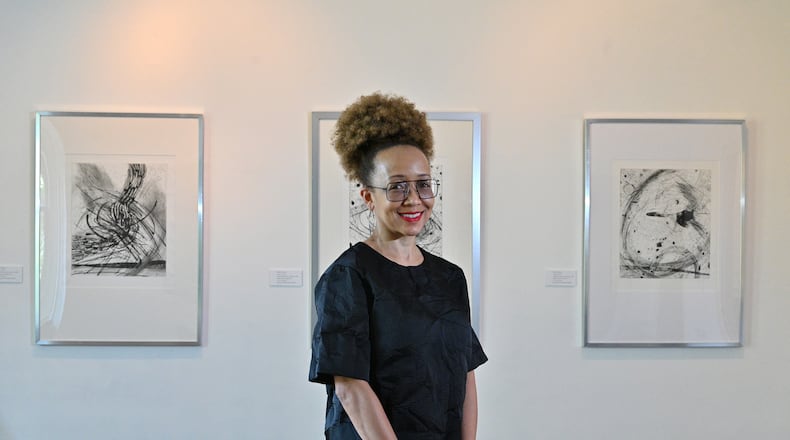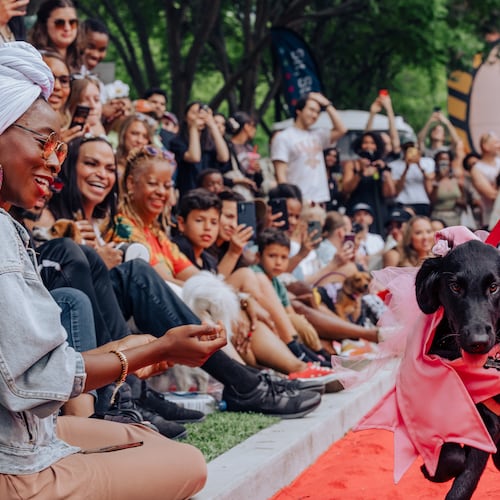Karen Comer Lowe looked at the young couple standing in the vestibule of her new professional home, Hammonds House Museum, and she knew.
The couple was sharply dressed on that Sunday afternoon, as though they had come to the museum straight from church. It was “Family Day” at Hammonds House and a steady stream of visitors took advantage of the free admission. But as people milled about the converted West End Victorian mansion, gazing at paintings and installations, the couple stood frozen in the entrance.
As the new executive director and chief curator of the museum, Comer Lowe walked over to the couple, smiled warmly and welcomed them. Then, following her intuition, she asked if this was their first time to a museum.
“’Yes, ma’am,’” Comer Lowe recalled the woman answering. Then the young woman asked her own question of Comer Lowe.
“‘Like, what do we do here?’”
Without missing a beat, Comer Lowe walked the couple over to a watercolor of a young man standing at the edge of a field. She asked the pair what they saw. When they hesitated, she assured them that there were no wrong or right answers. The only goal was to look at each piece and consider how it made them feel, or, perhaps, how the works sparked their imaginations.
“She was hesitant at first, but I was so happy she felt comfortable enough to disclose what she didn’t know,” Comer Lowe said.
Credit: HYOSUB SHIN / AJC
Credit: HYOSUB SHIN / AJC
If there is one thing Comer Lowe wants to do during her tenure as the executive director and chief curator of the small but essential museum, it is to welcome new audiences through its doors, especially those who have never set foot in Hammonds House; or any museum. Along with the fine art museums at Clark Atlanta University and Spelman College, Hammonds House is part of a West End triangle of Black institutions that showcase Black art from the 1800s to the present. But as only the fourth director and chief curator in the museum’s 33-year history, Comer Lowe is clear that she has to remind the public that it is, in fact a collecting institution, not a gallery where the work is for sale. As was the intent of the founder of Hammonds House, the late Dr. Otis T. Hammonds, the mansion is a home for art by Black and African creators past and present. Comer Lowe said she wants more people to see that vision.
“How do you diversify? You make the art accessible,” Comer Lowe said.
The museum’s latest show, and Comer Lowe’s first since succeeding former executive director Leatrice Ellzy Wright in June, was curated from the museum’s permanent collection of just over 400 works. The show spans from 1859, with a chaste portrait by Robert Duncanson to a bold, cutting fantasy by contemporary Atlanta painter Kojo Griffin. The other 50 works in the show are by some of the canon’s titans: Hale Woodruff, Charles White, Elizabeth Catlett, Bill Traylor, Romare Bearden, James Van Der Zee, Nellie Mae Rowe, Jacob Lawrence, Samella Lewis, William H. Johnson, Lois Mailou Jones, Mildred Thompson, and Radcliffe Bailey among them. While the show’s official title is “Exhibiting Culture: Highlights from the Hammonds House Collection,” Comer Lowe, not half jokingly, calls it “Black Art 101.”
“Going through the collection to do this show really was like Christmastime,” Comer Lowe said. “I was like, ‘Look at this! Look at this!’”
Credit: HYOSUB SHIN / AJC
Credit: HYOSUB SHIN / AJC
The show is on view now through Jan. 30.
“To Reflect Us”
At first glance, the small signs bordering the museum’s front walkway look like campaign ads. On closer look they serve as welcome signs signaling what’s behind the front door. Each bears a photo of an artist featured inside, accompanied by a quote on their artistic philosophy, but also what it means to be a Black creator, from the responsibilities and burdens to the joys and freedoms. Like this one from sculptor Elizabeth Catlett where she explains that for her, art is a force for liberation: “I have always wanted my art to service my people — to reflect us, to relate to us, to stimulate us, to make us aware of our potential.”
Credit: HYOSUB SHIN / AJC
Credit: HYOSUB SHIN / AJC
The figure of a child rests inside Catlett’s small sculpture of a female figure, standing in a case across from a stunning silver platter by Charles White. The platter appears tarnished and smudged on one side. But within the gray film, White etched the face of a young Black boy gazing upward, expectantly. The 1973 piece, originally acquired by Dr. Hammonds for his personal collection, is called “Vision.”
“I’ve never seen anything like that from Charles White on the market,” Comer Lowe said.
Across the room from both is an early Radcliffe Bailey work, “Places of Rebirth.” Rusted shackles encased in plexiglass in the center of the piece are a blunt reference to enslavement. The space between all three works is a reminder of the physical and psychic journey African Americans have experienced for four centuries.
Credit: HYOSUB SHIN / AJC
Credit: HYOSUB SHIN / AJC
This is actually Comer Lowe’s second stint at Hammonds House. Hammonds purchased the house and began renovating it as his personal residence and to house his art collection of roughly 250 pieces in the late 1970s. He died before he could completely move in, and by 1985, friends of the doctor and then Fulton County Chairman Michael Lomax convinced the Fulton County Commission to buy the property and turn it into a museum with Hammonds’ collection. (The museum is now a non-profit, but still receives some funding from Fulton County). Comer Lowe joined Hammonds House as a young curator working under the museum’s first executive director, Ed Spriggs, before leaving for a career as a private art consultant, arts administrator and curator. Over the years she worked at the Smithsonian Institution’s National Portrait Gallery, the Tubman African American Museum and the Whitney Museum of American Art.
What convinced her to leave her last position as curator of the Chastain Arts Center, she said, was Hammonds’ permanent collection. The Atlanta native had first learned of masters like Jacob Lawrence and Catlett while a student at Howard University, where she was taught by the dean of art curators and Black art educators, David Driskell.
The West End museum offered her a chance to work not only with their paintings and sculptures, but also to grow an already venerable collection with work by contemporary artists such as Griffin, Renée Stout and Bailey. To expand the holdings, however, she must fundraise. While the museum received what Comer Lowe said was a significant grant from Fulton County this year, she still has to raise the remainder of the annual budget, which during Wright’s tenure was around $300,000 annually.
So, Comer Lowe has revamped the museum gift shop and is taking it online. She’s ramping up the museum’s Instagram presence. There are plans for private fundraisers and donor gatherings. And there’s always the drive for memberships. But for now, Comer Lowe is focused on making Hammonds House a destination for in-town and out-of-town guests, both seasoned and novices.
She thinks back to the day when as a Howard student she looked at William H. Johnson’s paintings and “saw this story about Black people who looked like me,” she said. Then she bought a poster of his iconic painting of a family on an ox-drawn wagon and hung it in her dorm her junior and senior year at Howard. In the portrait, everyone is dressed in their finest clothes. It’s called, “Going to Church.”
EVENT PREVIEW
“Exhibiting Culture: Highlights From the Hammonds House Museum Collection”
Through Jan. 30. 11 a.m.-5 p.m. Fridays-Saturdays; noon-5 p.m. Sundays. $5-$10. 503 Peeples St. SW, Atlanta. 404-612-0481. www.hammondshouse.org.
About the Author
Keep Reading
The Latest
Featured







